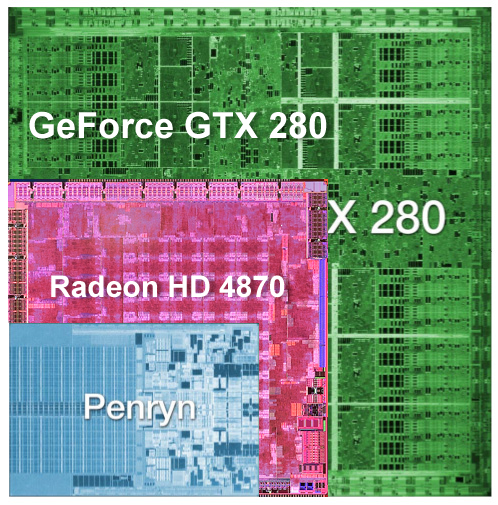The Radeon HD 4850 & 4870: AMD Wins at $199 and $299
by Anand Lal Shimpi & Derek Wilson on June 25, 2008 12:00 AM EST- Posted in
- GPUs
AMD's "Small-Die" Strategy
We outlined AMD's "new" GPU strategy in our Radeon HD 4850 preview article, but in short AMD has committed to designing GPUs for the mainstream $199 - $299 segment and simply using CrossFire (multi-GPU) to address higher end markets. NVIDIA on the other hand will continue to make very large monolithic GPUs in order to continue to push the industry forward. Both approaches are appreciated and necessary, they simply target different markets.
In our GT200 review we highlighted the fact that NVIDIA had built an extremely large, highly parallel, microprocessor. With 1.4 billion transistors and a die size of around 576 mm^2, NVIDIA's GT200 is nothing short of huge.
The table on the previous page shows that AMD's RV770, despite being aimed at mainstream gamer price points ($199 - $299), is also very large. At 956M transistors, the RV770 has 44% more transistors than RV670 and 68% the transistor count of NVIDIA's GT200. We threw the RV770 into NVIDIA's die size comparison just for kicks:

Based on what we know of NVIDIA's die size, this should be to scale
Even AMD's die, although designed to be svelte and affordable, is big - especially for being fabbed at TSMC. NVIDIA still holds the crown for largest die fabbed at TSMC, but AMD shows us that even a more mainstream approach still requires tons of transistors. As we mentioned in our 4850 preview:
"A pair of RV770s, AMD's new GPU, end up consuming more power than a single GT200 - despite being built on a smaller 55nm process.
A pair of these RV770s only costs $400 compared to $650 for a single GT200, but I suspect that part of that is due to differences in manufacturing process. If NVIDIA hadn't been so risk averse with the GT200 and built it on 55nm (not that I'm advocating it, simply posing a hypothetical), the cost differences would be smaller - if not in favor of NVIDIA since GT200 is built on a single card.
When the smoke clears, AMD's strategy is to simply build a GPU for the masses and attempt to scale it up and down. While NVIDIA is still building its GPUs the same way it has for decades, starting very large and scaling down.
AMD isn't taking a radically different approach to building and designing GPUs than NVIDIA, it's simply building one market segment lower."
We've got a lot of discussion on efficiency between AMD and NVIDIA coming up in this article, although AMD's die is noticeably smaller than NVIDIA's - as you've already seen with the Radeon HD 4850 - there are many areas where RV770 can go toe-to-toe with NVIDIA's mammoth GT200.










215 Comments
View All Comments
Final Destination II - Wednesday, June 25, 2008 - link
Dear girls and guys,does anyone know of a manufacturer, who offers a HD4850 with a better cooler? I'm desperately searching for one...
Please reply!
Graven Image - Wednesday, June 25, 2008 - link
Asus recently announced a 4850 with a non-stock cooler, though their version still doesn't expel the air out the back like a dual slot design. (http://www.asus.com/news_show.aspx?id=11871)">http://www.asus.com/news_show.aspx?id=11871). Its not available yet thought. My guess is mid-July we'll probably start seeing a couple different fan and heatsink designs.strikeback03 - Thursday, June 26, 2008 - link
Only dual-slot card I've ever used was an EVGA 8800GTS 640, it sucked air in the back and blew it into the case.Final Destination II - Wednesday, June 25, 2008 - link
Nice! 7°C cooler, that's a start! I guess I'll wait a bit more, then.Spacecomber - Wednesday, June 25, 2008 - link
Although I'm somewhat dubious about dual card solutions, I keep looking at the benchmarks and then at the prices for a couple of 8800 GTs.Perhaps, if the 4870 forces Nvidia to reduce their prices for the GTX 260 and the GTX 280, they will likewise bring down the price for the 9800 GX2. This is already the fastest single card solution, and it sells for less than the GTX 280. If this card starts selling for under $400 (maybe around $350), will this become Nvidia's best answer to the 4870?
Given the performance and the prices for the 4870 and the 9800 GX2 will Nvidia be able to price the GTX 280 competitively, or will it simply be vanity product - ridiculously priced and produced only in very small numbers?
It should be interesting to see where the prices for video cards end up over the course of the next few weeks.
kelmerp - Wednesday, June 25, 2008 - link
Better HD knickknacks? Better offloading/upscaling?chizow - Wednesday, June 25, 2008 - link
The HD4000 series have better HDMI sound support with 8ch LPCM over HDMI, but still can't pass uncompressed bistreams. Image quality hasn't changed as there isn't really any room to improve.kelmerp - Wednesday, June 25, 2008 - link
It would be nice to have a video card, where it doesn't matter how weak the current-gen processor is (say the lowliest celeron available), the card can still output 1080p HDTV without dropping any frames.Chaser - Wednesday, June 25, 2008 - link
Good to have back at the FRONT of the finish line.JPForums - Wednesday, June 25, 2008 - link
Ragarding the SLI scaling in Witcher:The GTX 280 SLI setup may be running into a bottleneck or driver issues, rather than seeing inherent scaling issues. Consider, the 9800 GTX+ SLI setup scales from 22.9 to 44.5. So the scaling isn't an inherent SLI scaling problem. Though it may point to scaling issues specific to the GTX 280, it is more likely that the problem lies elsewhere. I do, however, agree with your general statement that when CF is working properly, it tends to scale better. In my systems, it seems to require less CPU overhead.